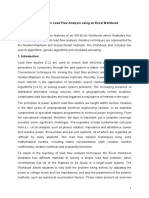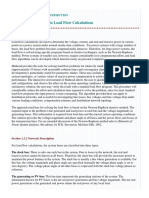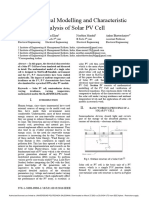Lect 08
Uploaded by
eswar110582Lect 08
Uploaded by
eswar110582INTRODUCTION TO LOAD-FLOW
Load-flow studies are probably the most common of all power system analysis
calculations. They are used in planning studies to determine if and when specific
elements will become overloaded. Major investment decisions begin with reinforcement
strategies based on load-flow analysis. In operating studies, load-flow analysis is used
to ensure that each generator runs at the optimum operating point; demand will be met
without overloading facilities; and maintenance plans can proceed without undermining
the security of the system.
The objective of any load-flow program is to produce the following information:
• Voltage magnitude and phase angle at each bus.
• Real and reactive power flowing in each element.
• Reactive power loading on each generator.
The above objectives are achieved by supplying the load-flow program with the
following information:
• Branch list of the system connections i.e., the impedance of each element,
sending-end and receiving-end node #. Lines and transformers are represented
by their π-equivalent models.
• Voltage magnitude and phase-angle at one bus, which is the reference point for
the rest of the system.
• Real power generated and voltage magnitude at each generator bus.
• Real and reactive power demanded at each load bus.
The foregoing information is generally available since it either involves readily
known data (impedances etc.) or quantities which are under the control of power system
personnel (active power output and excitation of generators.)
Simply stated the load-flow problem is as follows:
● At any bus there are four quantities of interest: │V│, θ, P, and Q.
● If any two of these quantities are specified, the other two must not be specified
otherwise we end up with more unknowns than equations.
● Because records enable the real and reactive power to be accurately estimated
at loads, P and Q are specified quantities at loads, which are called PQ buses.
● Likewise, the real power output of a generator is controlled by the prime mover
and the magnitude of the voltage is controlled by the exciter, so and P and │V│
are specified at generators, which are called PV buses.
● This means that │V│ and θ are unknown at each load bus and θ and Q are
unknown at each generator bus.
● Since the system losses are unknown until a solution to the load-flow problem
has been found, it is necessary to specify one bus that will supply these losses.
This is called the slack (or swing, or reference) bus and since P and Q are
unknown, │V│ and θ must be specified. Usually, an angle of θ = 0 is used at the
slack bus and all other bus angles are expressed with respect to slack.
The foregoing is summarized in the following one-line diagram in which the
specified quantities are italicized, while the quantities that are free to vary during the
iteration process are indicated with up-and-down arrows. Note that at each bus we can
write TWO node equations.
There are two major iterative techniques:
A. The Gauss-Seidel Method
The Gauss-Seidel method is based on substituting nodal equations into each
other. It is the slower of the two but is the more stable technique. It’s convergence is
said to be Monotonic. The iteration process can be visualized for two equations:
Although not the best load-flow method, Gauss-Seidel is the easiest to
understand and was the most widely used technique until the early 1970s.
Some software packages use Gauss-Seidel to start the solution process and
then switch over to:
B. The Newton-Raphson Method
The Newton-Raphson method is the most efficient load-flow algorithm. The
basic (no approximations) Newton-Raphson algorithm is based on the formal
application of a well-known algorithm for the solution of a set of simultaneous non-linear
equations of the form:
[F(x)] = [0]
Where: [F(x)] is a vector of functions: f1 --- fn in the variables x1 --- xn.
The above expression does not equal zero until the Newton-Raphson process
has converged (i.e., all the x's have been found) and the iterations have to be
performed, starting at some initial set of values x1, x2, --- xn. In the load-flow problem
the x's are voltage magnitude and phase angle at all PQ buses and voltage phase
angles at all PV buses i.e., angles at all buses except slack and │V│ for all load buses.
The iterations are performed by linearizing the non-linear equations [F(x)] = [0]
and adjusting the values of x. This process can be visualized in the case of a single-
variable problem, which could be formed by subtracting the two equations used at the
beginning of the Gauss-Siedel section, i.e.
f(x) = eqn 1 – eqn 2 {f(x) = 0 at the solution}
f(x) = 0 is the required solution.
o
The initial estimate is x ≈ x + Δx. This can be improved by applying
trigonometry once the function has been differentiated.
An estimate for Δx is obtained from:
Δx 0 = f ( x + Δx )
df ( x + Δx )
dx
Then the estimate of x is improved by:
x1 = xo - Δxo
Information available from load-flow studies
The basic information contained in the load-flow output is:
i) All bus voltage magnitudes and phase angles w.r.t the slack bus.
ii) All bus active and reactive power injections.
iii) All line sending- and receiving-end complex power flows.
iv) Individual line losses can be deduced by subtracting receiving-end complex
power from sending-end complex power.
v) Total system losses can be deduced by summing item iv) for all lines, or by
summing complex power at all loads and generators and subtracting the totals.
The most important information obtained from the load-flow is the voltage profile
of the system. If │V│ varies greatly over the system, large reactive flows will result; this,
in turn, will lead to increased real power losses and, in extreme cases, an increased
likelihood of voltage collapse. When a particular bus has an unacceptably low voltage,
the usual practice is to install capacitor banks in order to provide reactive compensation
to the load. Load-flow studies are used to determine how much reactive compensation
should be applied at a PQ bus, to bring its voltage up to an appropriate level, i.e.:
i) Re-execute the load-flow with the bus re-designated as PV type with the required
voltage level specified.
ii) Subtract the value of Q obtained from i) from the value obtained in the old load-
flow when the bus was PQ.
iii) The result is the value of Qc needed to bring the voltage up to the specified level.
Note that if the specified voltage is not 1 pu, then the value of Qc has to be
adjusted by 1/│V│2 in order to specify Qc at rated voltage.
If new lines (or additional transformers) are to be installed, to reinforce the
system, a load-flow will show how it will relieve overloads on adjacent lines. It will also
show how much reduction in losses will result from the new line (important for economic
assessment.)
You might also like
- Hourglass Workout Program by Luisagiuliet 276% (21)Hourglass Workout Program by Luisagiuliet 251 pages
- The Hold Me Tight Workbook - Dr. Sue Johnson100% (16)The Hold Me Tight Workbook - Dr. Sue Johnson187 pages
- Read People Like A Book by Patrick King-Edited62% (66)Read People Like A Book by Patrick King-Edited12 pages
- Livingood, Blake - Livingood Daily Your 21-Day Guide To Experience Real Health77% (13)Livingood, Blake - Livingood Daily Your 21-Day Guide To Experience Real Health260 pages
- COSMIC CONSCIOUSNESS OF HUMANITY - PROBLEMS OF NEW COSMOGONY (V.P.Kaznacheev,. Л. V. Trofimov.)94% (212)COSMIC CONSCIOUSNESS OF HUMANITY - PROBLEMS OF NEW COSMOGONY (V.P.Kaznacheev,. Л. V. Trofimov.)212 pages
- Donald Trump & Jeffrey Epstein Rape Lawsuit and Affidavits83% (1016)Donald Trump & Jeffrey Epstein Rape Lawsuit and Affidavits13 pages
- The 36 Questions That Lead To Love - The New York Times94% (34)The 36 Questions That Lead To Love - The New York Times3 pages
- The 36 Questions That Lead To Love - The New York Times95% (21)The 36 Questions That Lead To Love - The New York Times3 pages
- Jeffrey Epstein39s Little Black Book Unredacted PDF75% (12)Jeffrey Epstein39s Little Black Book Unredacted PDF95 pages
- The 4 Hour Workweek, Expanded and Updated by Timothy Ferriss - Excerpt23% (954)The 4 Hour Workweek, Expanded and Updated by Timothy Ferriss - Excerpt38 pages
- 6th Central Pay Commission Salary Calculator100% (436)6th Central Pay Commission Salary Calculator15 pages
- Topic: Load Flow Studies: Arshdeep Kaur Department of Electrical Engineering GNDEC, LudhianaNo ratings yetTopic: Load Flow Studies: Arshdeep Kaur Department of Electrical Engineering GNDEC, Ludhiana34 pages
- Power Flow Control To Determine Voltage Stability Limit by Using The Continuation MethodNo ratings yetPower Flow Control To Determine Voltage Stability Limit by Using The Continuation Method16 pages
- Power Flow Calculation by Combination of Newton-Raphson Method and Newton's Method in OptimizationNo ratings yetPower Flow Calculation by Combination of Newton-Raphson Method and Newton's Method in Optimization4 pages
- Power Flow Analysis Using P-SAT: Ashutosh Bhadoria, Dhananjay BhadoriaNo ratings yetPower Flow Analysis Using P-SAT: Ashutosh Bhadoria, Dhananjay Bhadoria6 pages
- Annotated-Power Systems Project %28ELEN4018A%29No ratings yetAnnotated-Power Systems Project %28ELEN4018A%2911 pages
- Notes On Power System Load Flow Analysis Using An Excel WorkbookNo ratings yetNotes On Power System Load Flow Analysis Using An Excel Workbook20 pages
- 1 - 3a Load Flow Calculations - Theory PDFNo ratings yet1 - 3a Load Flow Calculations - Theory PDF4 pages
- Load Flow Analysis of Jamshoro Thermal Power Station (JTPS) Pakistan Using Matlab ProgrammingNo ratings yetLoad Flow Analysis of Jamshoro Thermal Power Station (JTPS) Pakistan Using Matlab Programming5 pages
- Ee 258 Load-Flow Studies: Lecturer: Ambrosio T. Magtajas Nod-Mso, NGCP67% (3)Ee 258 Load-Flow Studies: Lecturer: Ambrosio T. Magtajas Nod-Mso, NGCP33 pages
- New Contributions To Load Flow Studies by The Method of Reduction and RestorationNo ratings yetNew Contributions To Load Flow Studies by The Method of Reduction and Restoration7 pages
- Summary of WECC Voltage Stability Assessment MethodologyNo ratings yetSummary of WECC Voltage Stability Assessment Methodology7 pages
- Load Flow Analysis: Presented by Dr. Sanjay Kumar Assistant Professor, NIT Jamshedpur100% (1)Load Flow Analysis: Presented by Dr. Sanjay Kumar Assistant Professor, NIT Jamshedpur20 pages
- Fast Decoupled Power Flow Unbalanced Radial Distribution SystemsNo ratings yetFast Decoupled Power Flow Unbalanced Radial Distribution Systems8 pages
- Investigation of the Usefulness of the PowerWorld Simulator Program: Developed by "Glover, Overbye & Sarma" in the Solution of Power System ProblemsFrom EverandInvestigation of the Usefulness of the PowerWorld Simulator Program: Developed by "Glover, Overbye & Sarma" in the Solution of Power System ProblemsNo ratings yet
- Reference Guide To Useful Electronic Circuits And Circuit Design Techniques - Part 2From EverandReference Guide To Useful Electronic Circuits And Circuit Design Techniques - Part 2No ratings yet
- AICTE Induction-Refresher Scheme DocumentNo ratings yetAICTE Induction-Refresher Scheme Document4 pages
- Impressions in Implant Dentistry: S. Bhakta, J. Vere, I. Calder and R. Patel0% (1)Impressions in Implant Dentistry: S. Bhakta, J. Vere, I. Calder and R. Patel7 pages
- Impressions in Implant Dentistry: S. Bhakta, J. Vere, I. Calder and R. Patel0% (1)Impressions in Implant Dentistry: S. Bhakta, J. Vere, I. Calder and R. Patel7 pages
- VF (Ky HKKJRH VK Qfozkku Lalfkku) JK Iqj Nÿkhlx +No ratings yetVF (Ky HKKJRH VK Qfozkku Lalfkku) JK Iqj Nÿkhlx +5 pages
- All India Institute of Medical Sciences Ansari Nagar, New Delhi - 110 029No ratings yetAll India Institute of Medical Sciences Ansari Nagar, New Delhi - 110 0292 pages
- Ge1101 - Engineering Practices Laboratory L T P C 0 0 3 2No ratings yetGe1101 - Engineering Practices Laboratory L T P C 0 0 3 23 pages
- LNG To Power Addendum To EsIA Project EIA PDFNo ratings yetLNG To Power Addendum To EsIA Project EIA PDF538 pages
- Mathematical Modelling and Characteristic Analysis of Solar PV CellNo ratings yetMathematical Modelling and Characteristic Analysis of Solar PV Cell5 pages
- Otakikpo Field 4" X 3Km Onshore Terminal Produce Water Pipeline ProjectNo ratings yetOtakikpo Field 4" X 3Km Onshore Terminal Produce Water Pipeline Project53 pages
- Laboratory Manual - CEL-II - Jan8 2018 PDFNo ratings yetLaboratory Manual - CEL-II - Jan8 2018 PDF137 pages
- Livingood, Blake - Livingood Daily Your 21-Day Guide To Experience Real HealthLivingood, Blake - Livingood Daily Your 21-Day Guide To Experience Real Health
- COSMIC CONSCIOUSNESS OF HUMANITY - PROBLEMS OF NEW COSMOGONY (V.P.Kaznacheev,. Л. V. Trofimov.)COSMIC CONSCIOUSNESS OF HUMANITY - PROBLEMS OF NEW COSMOGONY (V.P.Kaznacheev,. Л. V. Trofimov.)
- Donald Trump & Jeffrey Epstein Rape Lawsuit and AffidavitsDonald Trump & Jeffrey Epstein Rape Lawsuit and Affidavits
- The 36 Questions That Lead To Love - The New York TimesThe 36 Questions That Lead To Love - The New York Times
- The 36 Questions That Lead To Love - The New York TimesThe 36 Questions That Lead To Love - The New York Times
- Jeffrey Epstein39s Little Black Book Unredacted PDFJeffrey Epstein39s Little Black Book Unredacted PDF
- The 4 Hour Workweek, Expanded and Updated by Timothy Ferriss - ExcerptThe 4 Hour Workweek, Expanded and Updated by Timothy Ferriss - Excerpt
- Topic: Load Flow Studies: Arshdeep Kaur Department of Electrical Engineering GNDEC, LudhianaTopic: Load Flow Studies: Arshdeep Kaur Department of Electrical Engineering GNDEC, Ludhiana
- Power Flow Control To Determine Voltage Stability Limit by Using The Continuation MethodPower Flow Control To Determine Voltage Stability Limit by Using The Continuation Method
- Power Flow Calculation by Combination of Newton-Raphson Method and Newton's Method in OptimizationPower Flow Calculation by Combination of Newton-Raphson Method and Newton's Method in Optimization
- Power Flow Analysis Using P-SAT: Ashutosh Bhadoria, Dhananjay BhadoriaPower Flow Analysis Using P-SAT: Ashutosh Bhadoria, Dhananjay Bhadoria
- Notes On Power System Load Flow Analysis Using An Excel WorkbookNotes On Power System Load Flow Analysis Using An Excel Workbook
- Load Flow Analysis of Jamshoro Thermal Power Station (JTPS) Pakistan Using Matlab ProgrammingLoad Flow Analysis of Jamshoro Thermal Power Station (JTPS) Pakistan Using Matlab Programming
- Ee 258 Load-Flow Studies: Lecturer: Ambrosio T. Magtajas Nod-Mso, NGCPEe 258 Load-Flow Studies: Lecturer: Ambrosio T. Magtajas Nod-Mso, NGCP
- New Contributions To Load Flow Studies by The Method of Reduction and RestorationNew Contributions To Load Flow Studies by The Method of Reduction and Restoration
- Summary of WECC Voltage Stability Assessment MethodologySummary of WECC Voltage Stability Assessment Methodology
- Load Flow Analysis: Presented by Dr. Sanjay Kumar Assistant Professor, NIT JamshedpurLoad Flow Analysis: Presented by Dr. Sanjay Kumar Assistant Professor, NIT Jamshedpur
- Fast Decoupled Power Flow Unbalanced Radial Distribution SystemsFast Decoupled Power Flow Unbalanced Radial Distribution Systems
- Investigation of the Usefulness of the PowerWorld Simulator Program: Developed by "Glover, Overbye & Sarma" in the Solution of Power System ProblemsFrom EverandInvestigation of the Usefulness of the PowerWorld Simulator Program: Developed by "Glover, Overbye & Sarma" in the Solution of Power System Problems
- Reference Guide To Useful Electronic Circuits And Circuit Design Techniques - Part 2From EverandReference Guide To Useful Electronic Circuits And Circuit Design Techniques - Part 2
- Impressions in Implant Dentistry: S. Bhakta, J. Vere, I. Calder and R. PatelImpressions in Implant Dentistry: S. Bhakta, J. Vere, I. Calder and R. Patel
- Impressions in Implant Dentistry: S. Bhakta, J. Vere, I. Calder and R. PatelImpressions in Implant Dentistry: S. Bhakta, J. Vere, I. Calder and R. Patel
- All India Institute of Medical Sciences Ansari Nagar, New Delhi - 110 029All India Institute of Medical Sciences Ansari Nagar, New Delhi - 110 029
- Ge1101 - Engineering Practices Laboratory L T P C 0 0 3 2Ge1101 - Engineering Practices Laboratory L T P C 0 0 3 2
- Mathematical Modelling and Characteristic Analysis of Solar PV CellMathematical Modelling and Characteristic Analysis of Solar PV Cell
- Otakikpo Field 4" X 3Km Onshore Terminal Produce Water Pipeline ProjectOtakikpo Field 4" X 3Km Onshore Terminal Produce Water Pipeline Project






















































































































